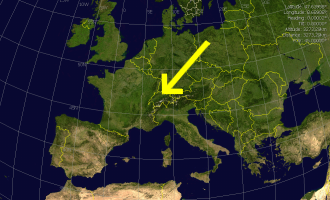Overview of the DHW system

We live in the southern part of Germany, the exact position you can see in the detailed map (our location is the cross in the middle). While this is "southern", it's still the latitude of the southern border of Canada!
The climate here is central European, which is influenced by the gulf stream. This results in relatively warm weather, but it also results in cloudy or misty times, especially in autumn or early winter.
My goal was to have a solar system that can provide me with warm water over several days without sun, which does happen quite often, at least with the mist starting in october.
Base for my decisions was the fact here in Germany that collector area is cheap: the panels chosen cost about 350 EUR for 2.7 m2 (2.5 m2 effective area), but we get 110 EUR for each m2 subventioned by the state!
So I had no problem to use as much of collector area as needed. Due to our heating system (standard radiators), I decided against support of the heating system by the solar collectors, only hot water. Which suggests an area of 5-7 m2 for a house of our size (140 m2, 5 persons - 2 adults, 3 kids).
Then I thought I would try to get the yearly gain curve as "flat" as possible by arranging the collectors in about 30 degrees from the vertical (that is, really steep!), which is optimized for late autumn (end of october) and spring (midth of february), and in two rows below each other (see picture in 'Outside View') so that the lower one is a bit shaded by the upper row in the high summer time. Both reduces efficiency intentionally during the summer. This also induces an increase in area, as the effective area in the summer is much smaller, and the sun in winter much less strong.
And as the costs of the installation - nearly half the total costs! - are not very dependent on the size of the system, it makes sense to install a large system.
After some thoughts and a lot of reading, I bought a 500 liter reservoir which is heated up by about 10 m2 effective panel area. The exact description of the system can be found in the sections that you can choose in the menu on top.
Costs
Yup, this is the part that hurts <grin>. I did not put too much work in grouping the bills. But I have a rough draft:
- 3350 EUR for the integration into the old heating (heat reservoir, pipes, mechanic)
- 300 EUR lifting platform (4 days)
- about 3000 EUR for the rest (about 15 m pipes in each direction, panels, panel mount angles, isolation, pump station, all kinds of pipe connections, pipe holders and other mounting material, solar control and data connector, stainless steel screws, air valves, 3-way-valve, heat exchanger, soldering material, ...). Don't underestimate the small parts!
Result
This system works very nice since its installation in march 2005: I needed the heating only twice up to october to warm up the water when we had 4 days of bad weather, and I rarely had the situation that the collectors did overheat (three or four times IIRC, two of these when we were on holidays, when no hot water was needed). As the isolation was improved a lot since then, I assume I will really seldom need any oil between late spring and at least early automn. (Addition 2006-02-02: well, if there were not the usual 'misty' weather, hiding the sun for weeks!)
Before this system, we already used very little oil for heating the water, as we only had two time slices in the morning and evening to heat up the water (staying warm for about 6 hours), which reduced oil needed for hot water to 1/2 or 1/3 of before, when hot water was available from 5 in the morning up to 10 in the evening. This needed about 1.5 liters of oil per day (one hour running the burner of our 14 kW heating system). After reducing this to the time slices, oil consumption reduced considerably. See also the Graphs section.
So although it looks pretty, it's unlikely the system will be economical, as it will most likely never save me money, but ecology is nice too :))